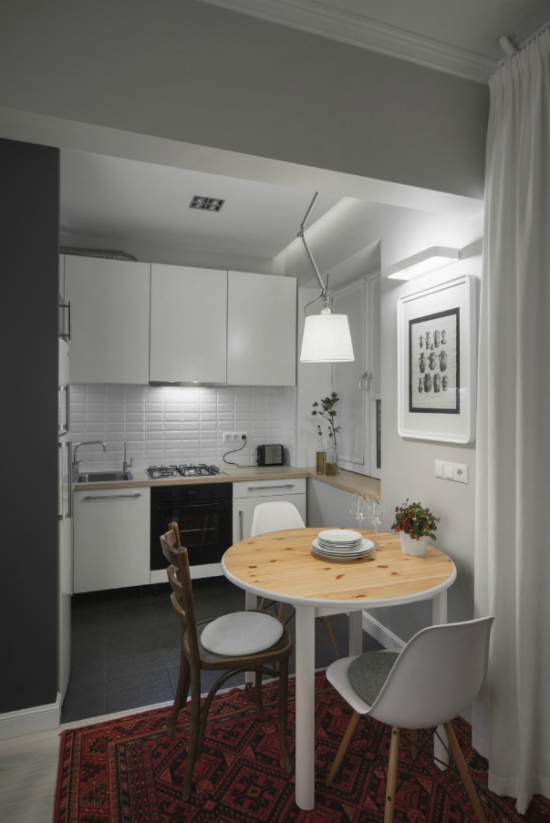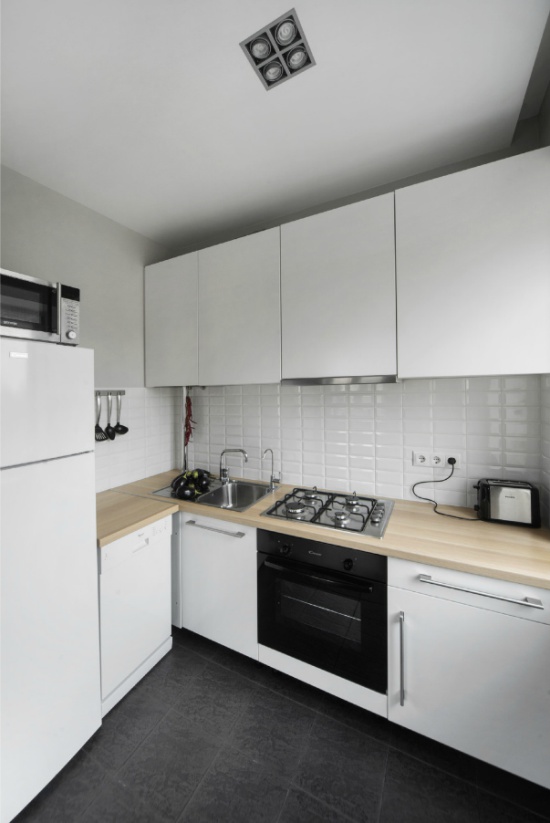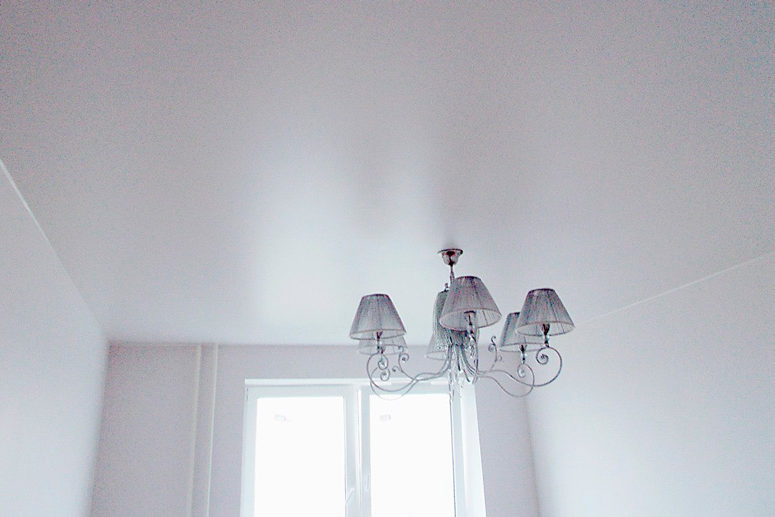How to choose stretch ceilings for the kitchen
Are stretch ceilings suitable for the kitchen? And if so, which is better to choose: matte or glossy, fabric or vinyl? How to choose a material manufacturer and what to look for when ordering? In this article we will answer these and other questions, as well as show a selection of real photos of stretch ceilings in the kitchen interior..
Pros and cons of stretch ceilings (general)
So, a stretch ceiling is a fabric or PVC canvas stretched over a ceiling molding made of a metal profile.
- Vinyl stretch ceiling is made of PVC and looks more like a film. Installation of PVC stretch ceiling is carried out using a heat gun.

Glossy ceiling in the kitchen

Matte vinyl stretch ceiling in the kitchen
- The fabric stretch ceiling is a thin but tarp-strong polyester fabric impregnated with polyurethane. Its installation involves pulling it onto the frame without using a gun..

Fabric ceiling in the kitchen
We divided the characteristics of stretch ceilings into pros and cons in the following table.
| Affordable price (PVC films). | |
| Retain water in case of flooding. Vinyl ceilings can hold up to 100 liters of water per square meter. m. The drainage of water, as a rule, is carried out through the hole for the lamp. After the flood, the vinyl is returned to its original state with a heat gun / high-power hair dryer or by natural drying in a few days. But fabric canvases do not have such an advantage and can retain water only up to 2 days.. | Loss of wall height. The minimum loss of height will be 4 cm.If you need to mount lamps in a stretch ceiling, then its height is reduced by 5-7 cm. |
| It is possible to hide communications and wiring. So, for example, when installing a stretch ceiling, you can equip the kitchen with spotlights and hang the chandelier right above the table. | The presence of seams on vinyl ceilings (with a large kitchen area). Firstly, the seams, although they are hardly noticeable (their thickness is less than 1 mm), can be seen upon close examination. Secondly, seams are the weak point of vinyl ceilings. In case of poor-quality welding or due to too strong tension during installation, the web can break exactly along the seam (this does not happen often). |
| Installation of stretch ceilings takes 1-4 hours with almost no dirt. | Airtightness of PVC ceilings together with high humidity can cause mold. Condensation on pipes, flooding and any leaks will make the sealed ceiling space a favorable environment for the development of mold and mildew. In addition, due to the stretch ceiling, it will not be possible to notice and fix the problem in time. What to do to protect the ceiling from mold, read in the second half of the article. |
| Durability. The service life can be more than 50 years, the warranty period is usually 10-15 years. | A small edging (most often plastic) is installed along the perimeter of PVC ceilings. Ideally, it should be covered with a ceiling plinth.. |
| Always a neat look, perfectly flat surface. | Unpleasant smell at first. This is often the case for both fabric and vinyl ceilings.. |
| Design variability. Stretch ceilings made of PVC can be matte, glossy, satin (with satin sheen). Any photo printing is also possible, combination with plasterboard level ceilings. Fabric stretch ceilings are generally matte and come in 20 shades to choose from. | A fabric ceiling will not save you from flooding, but it is much stronger than PVC film. In theory, vinyl can be damaged by a sharp object (for example, a spatula when gluing wallpaper) or a flying champagne cork. Sometimes damage to PVC film occurs due to poor quality material or improper installation. Local repair of stretch ceilings (both fabric and vinyl) is possible only in some cases. |
| Easy care. Vinyl ceilings should be washed every 1-2 months with soapy water, a microfiber cloth and a mop. Fabric ceilings need to be cleaned only with a dry method (wet method in extreme cases), individual dirt can be easily removed with a damp cloth without any streaks. | |
| Fire safety. Stretch ceilings do not support combustion, in a fire they curl up and melt without emitting toxic fumes. | |
| There is no need to level the ceiling. This saves a lot of time and effort.. | |
| Stretch ceilings are resistant to temperature extremes, high humidity. |
In this photo you can see the edging along the perimeter of the stretch ceiling and how the film bypasses the pipes (a plastic decorative plug is installed around the pipes).

This is what a stretch ceiling looks like when flooded.

Which stretch ceiling is better to choose for the kitchen – fabric or PVC?
It is difficult to unequivocally answer the question of which stretch ceiling is better – fabric or PVC film. The choice rests on the personal preferences of the buyer, the budget and the initial data of the premises. We have already indicated some of the differences between fabric and vinyl ceilings in the table above. Now let’s look at them in more detail..
- The main advantage of fabric ceilings is that they breathe, which means they do not allow dampness and mold to form in the ceiling space. The second important plus is the seamlessness of large canvases..
Fabric ceilings also have other advantages: they are 15 times stronger, easier to clean (do not attract dust), are compatible with all lamps, provide better heat and sound insulation, are quicker to install and perfectly tolerate cold (fabric ceilings can be installed in summer cottages). kitchens).
- The main disadvantage of fabric ceilings is water permeability. But there is good news as well. Thanks to the polyurethane impregnation, the polyester fabric remains waterproof for two days. After this time, the polyurethane dissolves and water begins to flow. It turns out that there are 2 days to save the fabric stretch ceiling from flooding. Agree, this is better than nothing. True, the protective impregnation after prolonged contact with water will no longer be restored, and the canvas will most likely require painting.
Another unpleasant feature: within 2-3 years of operation, due to poor-quality installation, the fabric may shrink and then fall out of the baguette or bend the baguette away from the wall, creating a gap between them. The third drawback of fabric canvases is a higher price for 1 sq. m (200-250 rubles more than the cost of PVC). And finally, the fourth argument “against”: fabric ceilings are sold in only 20 shades and only with a matte finish.

By the way, the weaving of fabrics differs from manufacturer to manufacturer.
- Whereas PVC ceilings can be matte, glossy, satin, with the effect of mother-of-pearl, metallic or starry sky. The choice of colors is also varied and even photo printing on PVC film lays down brighter.

So, with the advantages of PVC ceilings it is clear: water resistance, design variability, low price. But here are a few disadvantages of PVC ceilings, which we did not mention in the table:
- Due to its weight, the vinyl sheet can give a slight sag after installation (about 1–2 cm).
- PVC ceiling is not compatible with all fixtures and lamps. The power of halogen lamps should be no more than 35 W, incandescent lamps – 60 W. If the light of the chandelier is directed upwards, then its lamps should be at a distance of at least 40-50 cm from the surface of the stretch ceiling. If these rules are ignored, yellow spots or folds may appear near the lamps..
Cloth is preferable if the ceiling in the kitchen has already been affected by mold in the past. We also recommend this type of ceiling for large kitchens and living room kitchens when you want to avoid seams. PVC ceilings are good for a limited budget, if the kitchen is not too big and is often flooded by neighbors, and also if you want to implement an unusual design idea..
Which stretch ceiling is better – matte or glossy?
If you can’t decide which stretch ceiling to choose for the kitchen – matte or glossy, then we recommend opting for the most win-win option – matte canvas. Here are some arguments “FOR” them:
- Matte ceilings practically do not differ externally from perfectly flat plaster. This finish looks noble and does not draw attention to itself.
- Matte ceilings are universal, suitable for any interior. Whereas glossy ceilings will fit only into an ultra-modern kitchen.

Matte stretch ceilings – the perfect choice for classic and rustic kitchens
- If small kitchen and low, then a glossy ceiling is contraindicated for her. The fact is that glare and reflections of objects on the canvas crush the space, create a feeling of excessive variegation and disorder. As a result, a small kitchen with a glossy ceiling seems even smaller and more cluttered..

Contrary to all myths, matte ceilings are more suitable for small kitchens than glossy ones.
- If you really like the shiny finish of the ceiling, then we advise you to pay attention to satin canvases. They have a slight sheen, reflect light pleasantly and can bring an airy feeling to a kitchenette..
- Matte stretch ceilings are 10-15% cheaper than glossy and satin ceilings.
- On matte PVC ceilings, seams are less visible (if any).
- Glossy ceilings in the kitchen are somewhat more difficult to maintain than matte ceilings. They are more visible stains, oily coating and dust..
Of course, glossy ceilings also deserve attention, but you need to choose them carefully. Below are a few photos of glossy ceilings in the interior..



5 top tips for choosing and installing stretch ceilings for the kitchen
- For the prevention of mold formation, it is better to purchase a stretch ceiling with built-in ventilation grilles with a diameter of 58 mm.
Also, before installing the canvas, it is necessary to treat the base with an antifungal primer or other antifungal agents based on chlorine or lime..
- It is desirable that the terms of the warranty agreement include free maintenance of the stretch ceiling in case of flooding. Otherwise, this service will cost from 4000 rubles.
- When choosing a stretch ceiling for a kitchen, check its fire safety class. You should not buy material with a class higher than KM-4 and without refractory impregnation. The lower the class, the more difficult it is to ignite the PVC ceiling, it supports combustion worse, produces less smoke and does not emit toxic substances in the event of a fire.
- Before installing stretch ceilings, carefully consider the layout of the lamps, especially if you want to save money. After all, the more lighting devices there are, the more expensive the installation service will be and the longer it will take (1 lamp = about 20 minutes of additional work).
- The main advice: you need to order a stretch ceiling only in companies with an excellent reputation. And, of course, it is important to choose a canvas of a well-known brand. Here is a list of the most sought after manufacturers:
- Pongs (Germany). The brand produces fabric ceilings under the Descor trademark, as well as vinyl ceilings.
- Clipso (France). The manufacturer manufactures fabric ceilings with the highest fire safety class (KM-1).
- Cerutti ST. The peculiarity of the fabric ceilings of this brand is complete waterproofness due to a double layer of varnish and protective impregnation.
- Renolit (Germany). Produces high-strength vinyl sheets with a thickness of 0.2–0.3 mm. Such a film can withstand up to 150 liters of water per 1 sq. meter instead of standard 100 l.
- Polyplast Trading & Manufacturing Company, PTMC (Belgium). The company offers the largest selection of shades and textures of stretch ceilings, as well as canvases with 3D photo printing..
- MSD (China). Inexpensive vinyl ceilings of good quality.





